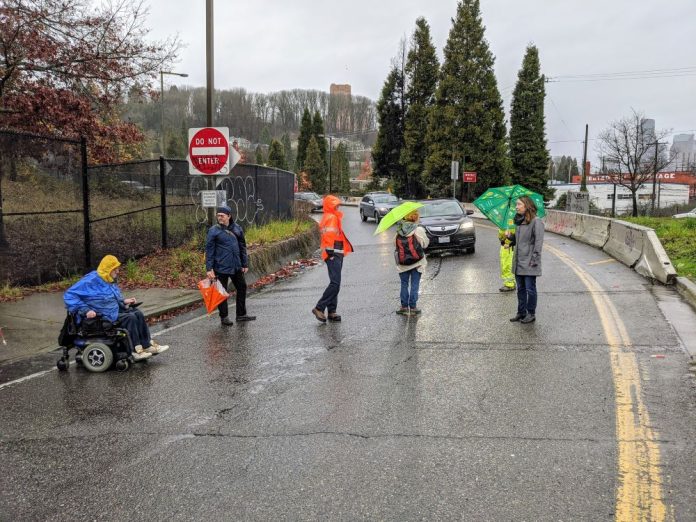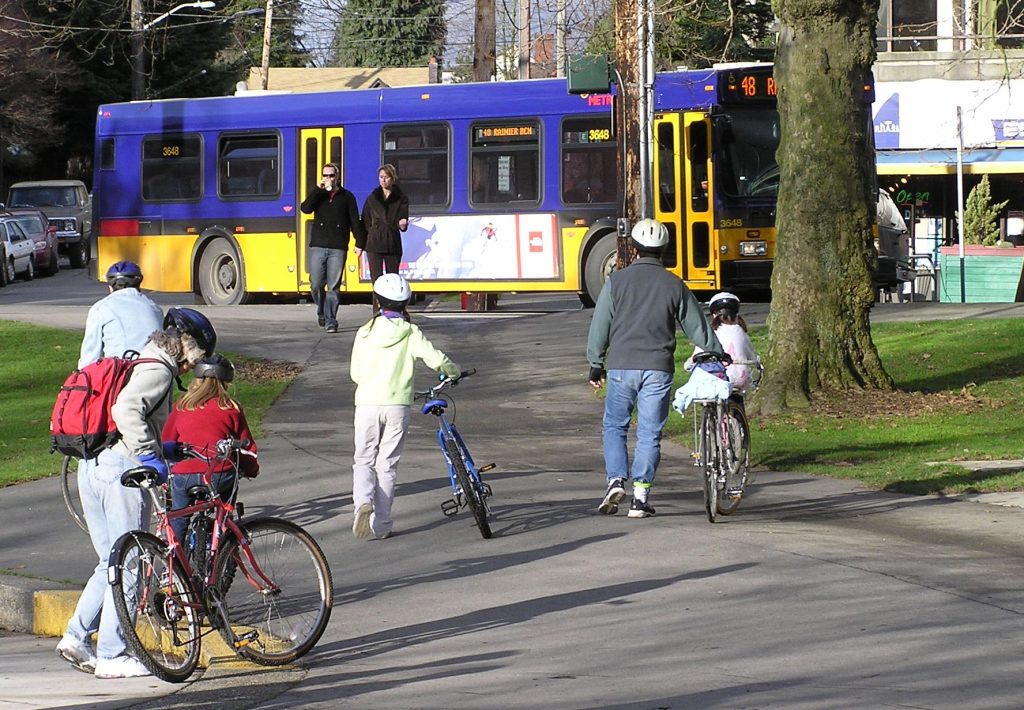
For the last hundred years, oil companies, car companies, airlines, global hotel brands, and the tourism industry have sold us travel as the ultimate elite experience. We are lured to enjoy the open road, the great outdoors, exotic white sand beaches and charming villages, made affordable by colonialism and global capital markets.
In big ways, the pandemic flipped the script. Rather than travel being a luxury, those with wealth and privilege now stay home, while essential workers, the people who stock our warehouses, pick our food, and care for others, are in motion. But patterns of who travels and doesn’t travel were nevel simple. Climate catastrophes, free trade policies, gentrification, and displacement lead to forced migrations. For others of us who can’t access cars, transit or safe routes to walk or roll, travel, even regional travel to a job or community meeting, isn’t possible.
And so in some ways, this pandemic, and the subsequent relaxing of requirements for “in person” participation has been revolutionary. Disabled and chronically ill folks who repeatedly have been denied work from home or school from home accommodations are suddenly seeing such accommodations widely available. Conferences have adopted all-online formats. City Council and other public meetings have found ways to accommodate public comment and participation remotely.
Granted, this is all with a huge caveat–there remain many people without access to reliable high speed internet or smartphones, as we’ve seen as schools have tried to move online. This extends to many disabled adults in group homes or assisted living facilities. At the most basic level, we hope this pandemic helps us make inroads to breaking down the digital divide so that everyone in our state can access online services.
But we also have the opportunity to ask bigger questions about our patterns of travel and participation. First, what would happen if we stopped idealizing the jetsetting lifestyle and questioned the value we’ve allowed capitalism to place on experiencing the exotic and new? What if we didn’t define freedom as travel? What if we defined freedom as community and place? You can ask chronically ill and disabled folks who long before COVID-19 learned how to build communities from home. What would it mean to build a new economy not centered around practices like jet travel that we know have extremely high environmental and public health costs?
But it’s not just about rethinking luxury travel. We need to think about how we configure the travel patterns in our daily routines. We’ve all seen the dramatic improvements in air quality by reducing non-essential travel and allowing more people to work from home. Can we maintain these gains by creating communities where we can get what we need with less travel, and less of us needs cars to get there?
At its core, reducing the number of cars on our streets and the miles they drive is a health equity issue. Air pollution from gasoline, diesel fuel and brake pad dust creates significant health risks to poor people and people of color who are more likely to live near high-traffic roads, industrial sites and airports. The impact of these health disparities have only been amplified by COVID-19. In story after story, we see the “underlying health condition” disclaimers attached the lives of people seriously sickened or killed by COVID-19, as if their lives were somehow more disposable. This was only reinforced when hospitals and medical professionals developed triage plans to ration access to care based on assumptions around the projected length and “quality” of the patient’s life.
We know the high public health costs of our auto-dependent communities. Scientists are finding a connection between exposure to air pollution and an increased risk of dying from COVID-19. And yet, because that cost is borne mostly by poor, disabled, brown and black folks, our elected leaders aren’t willing to challenge the status quo. But now is a moment of possibility. Both the highly visual manifestation of health inequities in COVID-19 deaths, and the radical shifts in travel patterns we’ve seen with the stay-at-home orders are providing an opening to push for more meaningful change.
It could be an inflection point that leads us to tear up exclusive zoning practices and build affordable housing close to our job centers. At the same time we could add incentives to have jobs, childcare and health centers distributed throughout our region instead of concentrated in downtown cores. What if we created policies that incentivize employers to allow people who didn’t need to work from fixed locations to work more often from home? And what if we did everything possible to build a world-class transit system, rather than allow our transit system to be gutted by revenue shortfalls?

The funding cliff facing transit systems across our country is terrifying, particularly when paired with the false narrative that “no one” will ride transit if it means being around other people, and so therefore cuts can be justified. Yes, transit ridership is down, but even with reductions in service, King County Metro still has 27% of their normal weekday ridership. It’s important to acknowledge that despite all the reasons not to ride transit right now, there are still many people who don’t have other options. A national survey found that only six percent of transit riders nationally right now have access to a car, and that they are overwhelming Black and Latinx women.
As the economic consequences of the pandemic deepen, more and more people will become transit-dependent out of economic necessity, just as we saw in 2008. Owning a car costs on average $9300 a year If families have the option to ride transit, that’s an average of $775 a month (per car) that can be spent on other necessities in these times of economic crisis. We need to not only return transit and paratransit to its previous level, we need to double down to expand our networks and frequency of service to ensure that as we come out of this crisis, the most economically vulnerable people in our communities can get around.
In addition to ensuring our transit agencies have the revenue they need to serve transit-dependent riders, as our region receives federal stimulus funds for transportation, we must fight to get that funding spent on infrastructure that induces more transit use, rather than more single-occupancy cars. Let’s build dedicated carpool lanes and bus lanes on all of our congested state highways and local roads. Let’s rebuild intersections for pedestrians, especially in areas that were designed exclusively to move cars at high speeds. Let’s connect our communities with smooth, wide sidewalks, multi-use paths and bike lanes.
“The system is broken for us already.” Those were the closing words of a presentation I put together in February paired with a photo of a group of pedestrians of mixed abilities trying to cross an I-90 off ramp along Rainier. Before the pandemic, we had successfully advocated for improvements installed along the I-90 onramps and offramps of Rainier to reduce the collision risk to people walking, rolling, taking transit and biking along this critical north-south corridor.
After the presentation was rescheduled, I went back to update my presentation and realized there wasn’t really much I needed to change. Because for disabled folks, poor folks, people of color, indigenous folks and immigrants, the fundamentals haven’t shifted. This pandemic has only made health disparities more obvious to those who the world was designed for. We don’t want to return to normal. We need to rethink our travel patterns and rebuild towards a transportation system that serves us.

Anna Zivarts
Anna Zivarts is a low-vision parent, nondriver and author of When Driving Is Not an Option: Steering Away from Car Dependency (Island Press, 2024). Anna launched the Week Without Driving challenge and directs the Disability Mobility Initiative at Disability Rights Washington, where she organizes to bring the voices of nondrivers to the planning and policy-making tables. Anna sits on the board of the League of American Bicyclists and serves as a member of the Transportation Research Board’s Committee on Public Health and Transportation.
